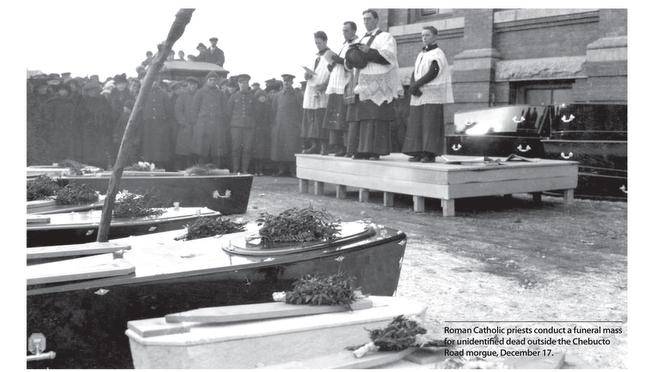JEN TAPLIN Published December 1, 2017 - 3:07pm, The Chronical Herald

An image from John Boileau's book 6/12/17. (CONTRIBUTED)
There are no black and white photos of a destroyed Halifax on the cover of the book, 6/12/17. It's just a black void with billowing grey smoke.
Author John Boileau, an army veteran, wanted to do something completely different for his first foray into the Halifax Explosion genre. His book is bursting with colour, photos, documents, images, stories, sidebars, facts and quotes. The author, who has written a dozen books of historical non-fiction, had touched on the Explosion before but never explored it, until now.
He says there's always a new story to tell in an event as massive as the Halifax Explosion.
Q: Why did you want to be a part of the Halifax Explosion book genre?
A: I didn't set out to be a part of it at all. I got a call in January 2016 from John MacIntyre of MacIntyre Purcell in Lunenburg. I was vaguely aware of the publisher but I had never spoken to them, didn't know John. He called me out of the blue one day and said, 'How would you like to write a book on the Explosion?' To which I replied, 'Are you serious? You must be joking.'
I thought, we're getting into a saturated market here, but he had an idea of what I think is a stunning collection of text and images that really pulls a reader along. I know a few people who said at first they thought, 'Oh, a coffee table book,' but then when they opened it up it's not just pictures with captions; there is actually a story being told. It's not just photographs but paintings, prints, artifacts plus the breaking up of the text with sidebars and quotes. It's all brought together with a gem of a designer, Denis Cunningham.
The research is the fun. And the problem with this book is I could write a million words on the Explosion easily, and find a million images of it, but it's getting it down to the essential core.
Q: So are you glad you left your doubts behind and wrote a book on the Explosion?
A: It had occurred to me to write a book on the Explosion but I didn't approach any publishers because I thought the field was saturated. But there is no book like this out there on the Explosion; there really isn't.
Q: How difficult was it for you — there are some heartbreaking stories in here — how do you deal with that?
When I wrote about some of those heartrending scenes I tried to write it in a way that would convey how I felt about it. I tried to really bring it home for people to almost experience what it was like. Let's face it: It was pretty bloody gruesome.
There are sanitized versions of stories of wartime, but we're talking about bits and pieces of bodies all over the place, horrible injuries, screaming, people blackened crawling along the street. You don't want to be too titillating but you do want to convey the magnitude of this disaster and what it did to people. I ended the book with (the question): Are the people of today with all our modern medical, transportation, communication and medical facilities, would our generation cope as well as those people did in 1917? I don't know what the answer to that is.
Q: Was there anything you learned about the Explosion you didn't know before?
A: I knew there was a major military, army and navy deployment in the rescue and recovery operation. I didn't realize when we have the annual memorial service up at the bell tower we have the first responders there in the form of firefighters and police but we don't really recognize the immediate rescue and recovery operations of the military. It's because there were so many soldiers and sailors in Halifax including 600 medical personnel that really saved the day for Halifax. They were a trained, disciplined body of men and women who were trained to react to the disaster of war. The Explosion was the nearest thing to war people could have imagined, and people who had been to the Western Front said the scenes of the disaster were as horrible as anything they had seen.
Canadian and American soldiers and sailors stepped right in and they covered bodies, treated the injured, put out fires, rescued people, and provided immediate medical assistance and transportation to hospitals.


Follow Us!